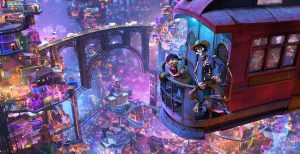For over 20 years, Pixar has been creating widely beloved masterpieces of animation, inviting audiences into dazzling worlds to tell heartwarming stories of friendship and love. Coco, the newest film by this peerless studio, tells the story of Miguel, a young boy in Mexico who wants to be a musician despite his family’s hatred of music. The film shows his journey through the Land of the Dead as he chases his dream and struggles to find a balance between his music and his family.
Pixar’s success in telling stories like Miguel’s is based not only on beautiful animation, but also a habitual dedication to creating realistic and relatable characters and stories. In the case of films like Coco, this dedication reveals itself in the years of research and development that serve to inspire the film and helped the filmmakers create a believable world onscreen.
Jason Katz, Coco’s story supervisor, has been working on the film since 2011. His research involved taking trips to Mexico and visiting families to learn about their cultures and traditions in order to create an accurate depiction of a Mexican family on-screen. Katz has worked at Pixar since 1994, serving as a storyboard artist or story supervisor on many projects and films. In an interview with the Voice, Katz commented on the years-long process that his team goes through to create a film. “It’s a marathon mindset – doing stories and doing them well, you have to be excited about the fight day to day, putting together the puzzle day to day.”
As a storyboard artist, Katz creates the initial drawings of the film by connecting the story development with later animation and laying a foundation for the rest of the film to be built around. As a result, he generally doesn’t see the animation built around his storyboards until he views the finished film, and he admitted that he usually has to watch the film several times before he isn’t distracted by all of the details created by other animators, adding, “It’s what’s fun about our movies, they can be overwhelming with what you’re being presented.”
But despite all of the dazzling details that other animators put into the film, the most important aspect of creating a Pixar film is, according to Katz, creating the story. With regard to the inspiration for all of the detail put into these films, Katz said that the story drives everything.
As an example of the importance of story in Coco, Katz discussed Miguel’s hideout, which he uses to get away from his family and play music. Katz described how the story called for a place for Miguel to be alone with his music. Inspired by a building they saw during one of their research trips to Mexico, the filmmakers created a small space tucked away in a corner of his family’s compound, where Miguel could play in peace. A scene of him playing there is one of the most emotional parts of the film, allowing the audience to recognize and connect with Miguel’s passion for music. In a testament to Pixar’s dedication to crafting a great story, the animation team developed several versions of this scene before finally choosing a touching display of musical and visual elements that strike the perfect balance between emotion and character development. Without the years of work put into this movie, a scene like that would not exist. “The beauty of Pixar, and the beauty about developing our films, is we have time to really dive in and to try things, and to try to solve story problems… but at the same time that we can find a level of specificity to the choices the character is making,” Katz said. In the case of Coco, that time helped the team to develop not only the film’s setting, story, and characters, but also its driving force: the music.
Although Coco is not a musical, it places a very strong emphasis on Mexican music, featuring characters that write, perform, and celebrate music throughout the entire film. This emphasis on music was inspired by the research trips the filmmakers took.
“When we were developing the film and especially when we went down to Mexico for our first trip down, one of the things that struck us was how present music was during the research trip,” Katz said. “Music was such a big part of those trips, and it seemed to be an emotional way that we were connecting with the subject matter that, well, it needed to be included, and as we developed the movie we started realizing that there was an opportunity to make music even more integral to the storytelling.”
Many other elements of Mexican culture are included in Coco as well, including the holiday of Dia de los Muertos, which provides the setting and source of conflict for much of the film. “If this is a person’s first time kind of learning about Dia de los Muertos, or learning about music in Mexico, or things of that nature, [hopefully] it inspires them to dig a little deeper,” Katz said. “Once we decided to make this movie, we felt like we were committed to trying to be as respectful and authentic as possible.”
As with all Pixar films, all of the research, detail, and music exists to contribute to one goal – the telling of a story that is based on universal themes of love and friendship. Although Dia de los Muertos is a Mexican holiday when families and ancestors are honored and remembered, the holiday ultimately proves that despite cultural differences, the familial values held by people worldwide share many similarities. At one point during the interview, Katz mentioned his recognition of universality in specific things during the making of the film. “We all come from somewhere, we all have families, we all stand on the shoulders of giants.”
By reminding its viewers of this simple fact, Coco reveals the human similarities that transcend cultural differences.





